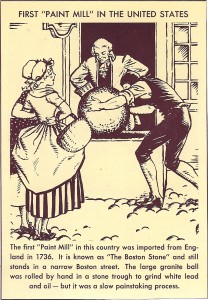House Painting had a rocky start in America. Pilgrims, known for their austere ways, looked upon the use of color in one’s home as a display of vanity and a sign that the owners enjoyed life too much. As history goes, in 1630, in Charlestown, a clergyman was charged with a sacrilegious crime for painting the interior of his house.
Needless to say, as the colonies grew and became more prosperous, those attitudes about paint and color began to change. However, because of the primitive paint-making process and the astronomical cost of paint in those days, house painting was regarded as a status symbol only a few could afford.
The high cost of house paints, coupled with a strong desire to have painted houses and a strong dose of American ingenuity, encouraged the development of home-grown substitutes to the expensive imported paint ingredients. Cookbooks of the time became the place where folks stored their paint recipes and recipes for many other necessities of the time.
The Dutch created a white wash from lime and oyster shells. Red oxide from iron was used to create reds and used them to trim houses and paint their barns. Copper oxide was used to produce vivid greens. Here is a recipe for creating a blue shade, common for interiors of the time: “Boil for three hours a pond of blue vitrol and one-half pound of best whiting in three quarts of water”. Skimmed milk, egg white, coffee, boiled rice were often used to produce those early home-made paints.
The nineteenth century brought the Industrial Age. In 1804, the first white lead plant was built in Philadelphia. In 1815, the first varnish plant was opened also n Philadelphia. Early in the 1800’s, Zinc Oxide white pigment was invented in Europe, which would eventually come to play a huge role in the popularization of house paints. But it was not until 1855 that a patent was first issued for what is known as the American process of zinc oxide making. Unlike white lead, zinc oxide was non-toxic and possessed other qualities, which made it an ingredient of choice for house paints.
The information for this post is derived from a 1946 supplement to the Armstrong Paint Company’s employee magazine, “The Armstrong Paint Pot”.








 Follow
Follow
